- Brain Artery Tree Data
- Companion Webpage to Book on Object Oriented Data Analysis
- Course Home Page – STOR 881 Object Oriented Data Analysis – Fall 2019
- Course Home Page – STOR 881 Object Oriented Data Analysis – Spring 2022
- Course Home Page – STOR 881 Object Oriented Data Analysis – Spring 2024
- Marron’s Home Page
- PanCancer2013 – Reduced Data Set
- Skwerer Brain Artery Tree Notes
- StudentConversation
- Thoughts About Statistics
J. S. Marron (Steve Marron)
Amos Hawley Professor of Statistics and Operations Research
Peter Hall Memorial Page
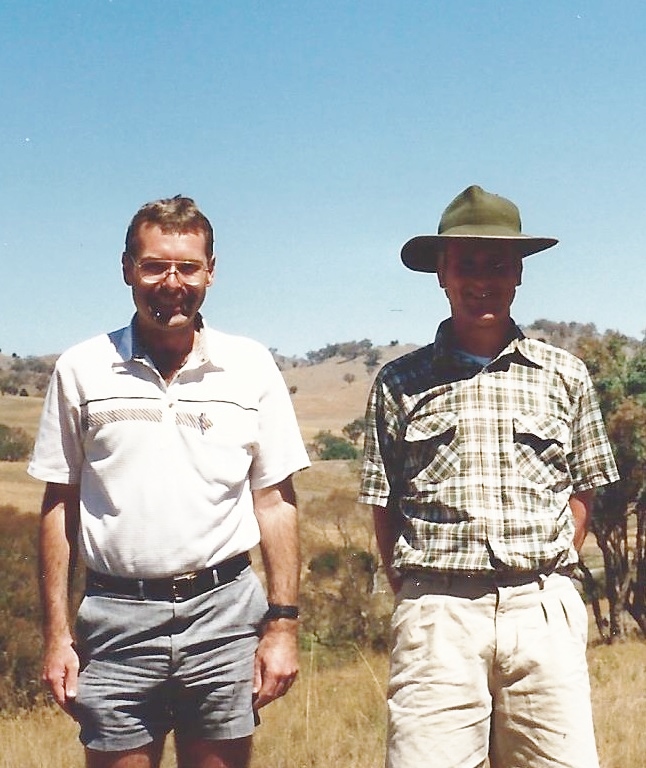
Peter Hall was a great scientist, a great mentor, and a great friend. I first met him when he visited the Center for Stochastic Processes at the University of North Carolina at Chapel Hill, during the Spring Semester of 1985. It was my pleasure to write many papers with him, listed farther down this page.
Some Personal Recollections:
I. Train Photography
Not everyone is aware that Peter was an avid photographer. For years he used a 70mm film camera (basically it had four times the film area of the conventional cameras of the time, which allowed him a lot of flexibility in cropping etc. at the time he chemically developed his pictures). Among his photographic passions was trains, and during the 1980s he published several photographs in railway magazines.
Early in my first visit to the Australian National University in Canberra in 1986 (during which I first met Matt Wand as he was just starting out as Peter’s PhD student), Peter said he was going out to photograph trains on Saturday, and asked if I would like to join. I envisioned this sedentary activity where we would go set up a tripod somewhere and have lots of time for idle discussion while waiting for trains to go by. It became clear something else was actually going to happen as we neared a place called Yass Junction (where the spur line to Canberra meets the main Sydney – Melbourne line). Just then a train came by, so Peter hurriedly pulled up to the Station Master’s building, ran inside and came out with handwritten notes of the train schedule for the day, then jumped in the car and tore off up a dirt road next to the track, chasing the train. The train has going up hill at the time, so we easily passed it, and Peter drove to a particular spot he knew, which he said was good for that time of day, to get an optimal sun angle on the train. The train came by, he took a pic, and we were back in the car racing up the dirt road to the next spot. This time there were some tall weeds in the way, so he actually tromped them down with his feet. While I was laughing about the whole idea of that he said “this is nothing, I have a friend who carries a chainsaw, so he can cut down old telegraph poles that might interfere with his train pics”. I believe this a picture of him photographing an oncoming train, which I took at that spot.
We then jumped back in the car, again moving ahead of the train. By this time, the road was two tire tracks, and there was a gravel embankment next to the road, and gravel had piled up between the two tire tracks to the point that Peter’s car got stuck on it and ground to a halt. I thought we were stuck, and would need to seek help. Peter said “No Worries!”, and started jiggling the steering wheel so the wheels of the car slightly climbed the embankment and the hill in between the tracks, going forward to get the right place for the next pic. Then he told me one time he got his car stuck in mud up to the floorboards. Then he did have to seek help from a local farmer who pulled him out with a tractor. Peter said it made a massive cork popping type of sound when the car was finally pulled free from the mud.
Having very much enjoyed that outing, when my late wife Faye visited Australia with me for the first time in January of 1989, I asked Peter to take us out photographing trains. Peter was reluctant, because he felt the sun was too high in the sky (for Northerners, recall January is mid-summer in the Southern Hemisphere) to give the right light for photography. But I twisted his arm as I knew Faye would enjoy the experience as much as I previously had. Ultimately Peter was happy we went out because he got a photo of the single engine in all of Australia that was painted with Bicentennial Colors at the time, which he ended up publishing in a railway magazine. Most of these pictures were taken at the place where he got that shot (either by Faye or myself).
Peter setting up his tripod in order to use a very fancy telephoto lens, which he used for that shot of the Bicentennial Engine:
Faye and Peter, I think just before he got the Bicentennial Pic:
“Feature Photograph” at the top of this page. Faye took this one of Peter and me. I am pretty sure it was just after Peter got the shot of the Bicentennial Engine. I am really happy that Faye had the presence of mind to get a picture of Peter’s face!
Peter’s car: This one had a good story behind it. One our way to that shot, Peter had made an impressively big splash going through the creek in his car. On the return trip, I asked Peter to let me get out so I could take a pic of his car splashing through the creek. He went splashing through, but our old manually wound camera failed to take the pic because Faye had forgotten to rewind it after the last pic (probably the one on the top of this page). Peter said “no worries!” and backed through the creek so he could go one more time, which is the pic you see here. Note the water splashing WAY above the top of the car!
Peter and Faye again: I think this was earlier in that trip, where Peter was taking a more conventional photo.
Here is a related photo of Peter taken by Ray Carroll, during the American summer of 1987, on a similar adventure.
II. Research with Peter
Peter’s prodigious publication record is there for everybody to see, and is widely known and understood. But I believe it is safe to say that those of us who had the pleasure of writing papers with Peter were most impressed.
On his first visit to Chapel Hill in 1984, we wrote two landmark papers in bandwidth selection. The first was [1] below. This was a natural thing for us to do during his visit since we were both keenly interested in bandwidth selection by cross validation for kernel density estimation. The very slow (n^-1/10) rate of convergence that we calculated for the first time in that paper was rather a surprise at the time. In talking that over, we began to wonder if it was a failing of cross validation, or if there was something inherent to the problem of bandwidth selection that led to such disappointing performance. Our discussions led us to the idea of trying to show that was the best possible rate, and we kicked around ideas for formalizing that for quite a while. There were two quite different approaches at the time. I had been trained by Charles Stone and pushed for using his approach. Peter was more familiar with the original approach of Farrell and tried hard to make that one work. We went back and forth for quite a while, but eventually I convinced Peter that Stone’s approach was in fact the way to get the results we were envisioning, and we finally saw our way through the proof. I received a really strong impression of Peter’s prodigious talents when he sat down on his last day in Chapel Hill and wrote out by hand a complete draft of the full paper in that single day. It was absolutely amazing. It would have taken me 1-2 weeks minimum. Of course I thought a lot about that experience, and my feeling is that when developing really complex proofs, I (and I guess most others) have to write out most aspects in pieces, since we can’t keep the whole thing in our heads at once. But Peter really had the capacity to keep it all in his head and write it down in one sitting. That was the first draft of our second joint paper [2].
III. Hall & Marron Publications
- Hall, P., & Marron, J. S. (1987). Extent to which least-squares cross-validation minimises integrated square error in nonparametric density estimation. Probability Theory and Related Fields, 74(4), 567-581.
-
Hall, P., & Marron, J. S. (1987). On the amount of noise inherent in bandwidth selection for a kernel density estimator. The Annals of Statistics, 163-181.
- Hall, P., & Marron, J. S. (1987). Estimation of integrated squared density derivatives. Statistics & Probability Letters, 6(2), 109-115.
- Härdle, W., Hall, P., & Marron, J. S. (1988). How far are automatically chosen regression smoothing parameters from their optimum?. Journal of the American Statistical Association, 83(401), 86-95.
-
Hall, P., & Marron, J. S. (1988). Choice of kernel order in density estimation. The Annals of Statistics, 161-173.
-
Hall, P., & Marron, J. S. (1988). Variable window width kernel estimates of probability densities. Probability Theory and Related Fields, 80(1), 37-49.
-
Hall, P., & Marron, J. S. (1990). On variance estimation in nonparametric regression. Biometrika, 77(2), 415-419.
-
Hall, P., Sheather, S. J., Jones, M. C., & Marron, J. S. (1991). On optimal data-based bandwidth selection in kernel density estimation. Biometrika, 78(2), 263-269.
-
Hall, P., & Marron, J. S. (1991). Lower bounds for bandwidth selection in density estimation. Probability Theory and Related Fields, 90(2), 149-173.
-
Hall, P., & Marron, J. S. (1991). Local minima in cross-validation functions. Journal of the Royal Statistical Society. Series B (Methodological), 245-252.
-
Härdle, W., Hall, P., & Marron, J. S. (1992). Regression smoothing parameters that are not far from their optimum. Journal of the American Statistical Association, 87(417), 227-233.
- Hall, P., Marron, J. S., & Park, B. U. (1992). Smoothed cross-validation. Probability Theory and Related Fields, 92(1), 1-20.
-
Grund, B., Hall, P., & Marron, J. S. (1994). Loss and risk in smoothing parameter selection. Journal of Nonparametric Statistics, 4(2), 133-147.
-
Hall, P., Marron, J. S., & Titterington, D. M. (1995). On partial local smoothing rules for curve estimation. Biometrika, 82(3), 575-587.
- Hall, P., Marron, J. S., & Titterington, D. M. (1996). A curious property of the derivatives of the Cauchy density. Statistics & probability letters, 27(3), 225-229.
- Hall, P., Marron, J. S., Neumann, M. H., & Titterington, D. M. (1997). Curve estimation when the design density is low. The Annals of Statistics, 756-770.
-
Hall, P., & Marron, J. S. (1997). On the role of the shrinkage parameter in local linear smoothing. Probability theory and related fields, 108(4), 495-516.
-
Devroye, D., Beirlant, J., Cao, R., Fraiman, R., Hall, P., Jones, M. C., Lugosi, G., Mammen, E., Marron, J.S., Sánchez-Sellero, C. & de Uña, J. (1997). Universal smoothing factor selection in density estimation: theory and practice. Test, 6(2), 223-320.
-
Hall, P., Marron, J. S., & Neeman, A. (2005). Geometric representation of high dimension, low sample size data. Journal of the Royal Statistical Society: Series B (Statistical Methodology), 67(3), 427-444.
-
Lee, M., Hall, P., Shen, H., Marron, J. S., Tolle, J., & Burch, C. (2013). Deconvolution estimation of mixture distributions with boundaries. Electronic journal of statistics, 7, 323.
- Lee, M., Wang, L., Shen, H., Hall, P., Guo, G., & Marron, J. S. (2015). Least squares sieve estimation of mixture distributions with boundary effects. Journal of the Korean Statistical Society, 44(2), 187-201.
IV. Additional Memories of Peter
- There were a number of occasions where I enjoyed hearing Peter’s proud updates as to what his wife Jeannie was doing. They met in late 1974 when they were both students at the University of Oxford. They were married in April 1977. Few of Peter’s colleagues are aware of Jeannie’s career in her own right. She worked for the Australian Federal Government for many years, and held a number of high profile (and high pressure) positions, including:
– Deputy Official Secretary to the Governor-General of Australia. The Governor-General is the Queen’s representative in Australia. As Deputy Official Secretary, Jeannie was the second-in-charge of the office of the Governor-General, including the Australian Honours and Awards Secretariat.
– Parliamentary Liaison Officer for the House of Representatives of the Parliament of Australia. She was responsible for programming all government business and legislation for debate in the House of Representatives.
– Senior Adviser of the Cabinet Secretariat in the Department of the Prime Minister and Cabinet. She was responsible for vetting all submissions to the Federal Cabinet and was also coordinator for the preparation of the Federal Government’s annual budget. - I well remember discussing Peter’s work with Sandor Csörgȍ (very creative Hungarian mathematical statistician who did some outstanding work in empirical processes) when I met the latter for the first time in 1988. Sandor told me that in the Eastern bloc (that was Iron Curtain days) there was a strong impression that because of the large number of papers appearing under that name, “Peter Hall” was a pseudonym for a consortium of authors such as the famous “Bourbaki” consortium. If you are not familiar with the latter, check out: https://en.wikipedia.org/wiki/Nicolas_Bourbaki
- In the 1980s there was some early bibliographical summary work done by Phillips et al (1988). This was not a simple task, because it was before the availability of online bibliographic data bases. They basically compared universities for their strength in theoretical statistics and also ranked individuals over the time window 1980-1986. Peter was the very clear winner in the individual category, but where it got fun was in comparing Peter’s record to aggregates for whole institutions, e.g. universities. On their overall score, Peter would have ranked as the 17th best institution in the world, ahead of such well known places such as UCLA, Michigan, Penn. State, & the Indian Statistical Institute. Similarly Peter was the 17th top institution in publications just in The Annals of Statistics.
- Prakash Patil (my PhD student, and Peter’s postdoc) did an excellent job of describing Peter’s strong and caring mentoring practices with the following quote: “I have read all the wonderful things people had said about Peter and felt good to read those, but there is something equally important that hasn’t been mentioned. That is, how encouraging he was to young statisticians. Of course, he was always quick to responds to all emails, but if it is from any young statistician he was doubly quick to respond to them and response was always positive and helpful.”
- At one point in my career, my own research was focusing too much on bandwidth selection for kernel smoothers. Peter suggested that I should be careful to avoid looking “too deeply into the eye of a fly”. The advice was on target, and it is my hope that my research since that time has lived up to his ideas on that point.
Reference:
Phillips, P. C., Choi, I., & Schochet, P. Z. (1988). Worldwide institutional and individual rankings in statistical theory by journal publications over the period 1980–1986. Econometric Theory, 4(01), 1-34. Web available at: http://dido.econ.yale.edu/korora/phillips/pubs/art/a055.pdf
V. BBQs at Tidbinbilla
Many of Peter’s ANU visitors have fond memories of an outing to the Tidbinbilla Nature Reserve. A quick look at their current website suggests that the place has been quite substantially upgraded since then.
Peter would usually build a fire in a BBQ in a picnic area. Here is a picture of him lighting the fire, in I think 1986.
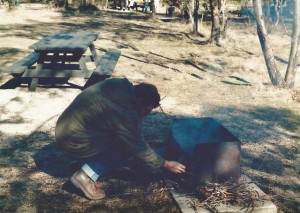 After the fire was going strongly, the usual procedure was to grill some sausages, to be shared by all. I still remember the first time he did this, he told me an occasional challenge was to keep emus from snatching the sausages straight off the grill. This sounded quite strange when he said it, and left me rather mind-boggled. But then, almost on cue, these amazingly massive birds walked straight in amongst us like they owned the place (and seemed to be hungry!). But this time they were sufficiently polite (perhaps not totally starved?) to allow us to take pictures while feeding them. I guess that was not their first encounter with tourists. Here are two pics in rapid succession of Peter photographing Jeannie bravely feeding an emu. For folks who have not experienced this, check out the size of those birds!
After the fire was going strongly, the usual procedure was to grill some sausages, to be shared by all. I still remember the first time he did this, he told me an occasional challenge was to keep emus from snatching the sausages straight off the grill. This sounded quite strange when he said it, and left me rather mind-boggled. But then, almost on cue, these amazingly massive birds walked straight in amongst us like they owned the place (and seemed to be hungry!). But this time they were sufficiently polite (perhaps not totally starved?) to allow us to take pictures while feeding them. I guess that was not their first encounter with tourists. Here are two pics in rapid succession of Peter photographing Jeannie bravely feeding an emu. For folks who have not experienced this, check out the size of those birds!
Here is another I took of Peter and an emu.
Finally I think Peter took this one of me using my camera.
Somehow I doubt the Tidbinbilla Nature reserve is currently organized to allow such experiences.
VI. More Photographs:
Two young statisticians hard at work:
Peter and Jeannie visiting North Carolina in 1988, amidst the construction of the garage of my home on Malvern Rd. in Durham. Note my old 1960 VW through the window:
VI. Some Relevant Links
- http://www.stat-center.pku.edu.cn/Peter_Gavin_Hall/
- http://tributes.canberratimes.com.au/obituaries/canberratimes-au/obituary.aspx?n=peter-gavin-hall&pid=177240277
Acknowledgement: Thanks to several friends that have offered useful comments on this page. Special thanks to Jeannie Hall, who has kindly provided helpful advice and corrections on a number of points.
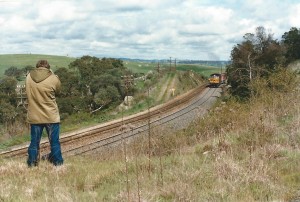
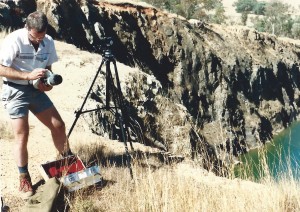
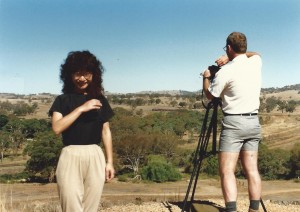
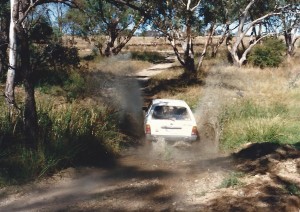
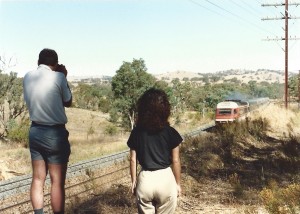
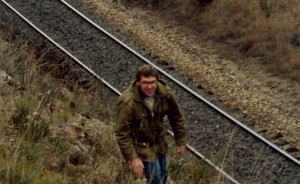
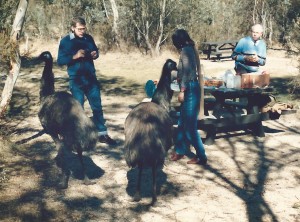
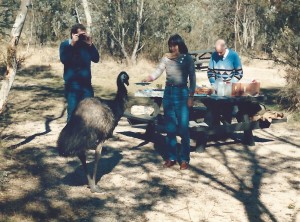
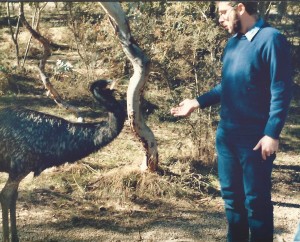
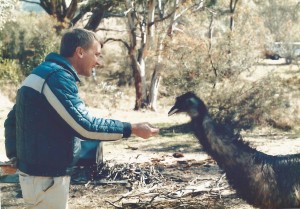
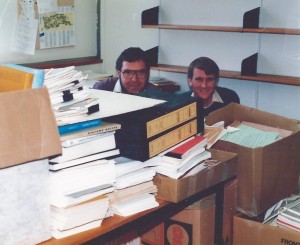


Recent Comments